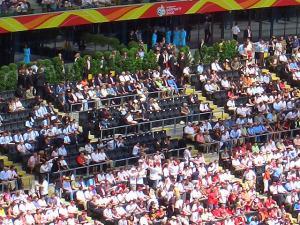Four weeks ago the Football Associations of Scotland, Ireland and Wales surprised the football world by expressing an interest in hosting Euro2020 in a three-way love in. Whilst not formally stating their intention to bid for the tournament, their dipping of the toe into the murky waters of International football was received in favourable terms by many people. Faced with competition from Turkey and Georgia at the moment, the Celtic bid looks very appealling.
Michel Platini, however, may think otherwise. He wasn’t very keen on inheriting the joint bid from Poland and Ukraine and has expressed his Gallic frustration on a number of occasions with the progress of the infrastructure which still isn’t quite finished despite the tournament kicking off in a week’s time. He also feels a bit guilty about France winning the bid for 2016 7-6 over Turkey where essentially he had the casting vote, so Turkey will be firm favourites. That is unless they win a bid for the 2020 Olympic Games.But do they really fit with UEFA’s vision for the Championships? We can glean quite a lot of information from the bid document for bids for 2016 on what UEFA expects from tournaments in the future.
The first thing to remind you is that from 2016 the tournament is being farcically expanded to a 24 nation competition, which based on the potential Celtic bid, will mean that 50 UEFA nations will be competing for 21 spots – hardly a taxing qualifying tournament. In terms of the tournament, UEFA set their infrastructure criteria for 2016 as:-
- 2 x stadiums with at least 50,000 net seating capacity (net meaning seats free from any obstructions) of which one should preferably have up to 60,000.
- 3 x stadiums with at least a 40,000 seating capacity
- 4 x stadiums with at least a 30,000 seating capacity
In addition there should be a maximum of three stadiums to be used as backup that fall within these parameters. All stadiums need to be at UEFA Category 1 level prior to the commencement of the tournament which has very little to do with design, facilities or even a fancy roof but more to do with the size of the Referee’s dressing room, the TV compound and the number of corporate boxes (40 for 30,000, 80 for 50,000+).

The good news for Wales, Ireland and Scotland is that the nations are actually blessed with good size stadiums already. If you apply the UEFA criteria then they are not far off having the infrastructure in place now. With the expanded tournament for 24 teams a minimum of 8 stadiums will need to be used but it is important to keep realism in check. Whilst Euro2004 was a wonderful tournament for those who went, the legacy it has left Portugal is not something that any nation will want to repeat. There is a big difference between the likes of Porto, Benfica and Sporting having UEFA 4 star 50,000+ seater stadiums and having 30,000 seater stadiums for the likes of Lieira, Aveiro and Faro who never have and never will get crowds in five figures.
50,000 + stadiums
Croke Park (Dublin) – 82,000 *
Millennium Stadium (Cardiff) – 72,500
Murrayfield Stadium (Edinburgh) – 67,130
Celtic Park (Glasgow) – 60,832
Hampden Park (Glasgow) – 52,063
Aviva Stadium (Dublin) – 51,700
Ibrox Stadium (Glasgow) – 51,082
Sub 30,000 stadiums
Cardiff City Stadium (Cardiff) – 26,828
Thormond Park (Limerick) – 25,600
Pittordrie (Aberdeen) – 22,200
Liberty Stadium (Swansea) – 20,532
Easter Road (Edinburgh) – 20,020
UEFA have only ever used 2 stadiums in the same city on one occasion (in Euro 2004 when Porto and Lisbon both had 2 stadiums), which would probably mean one of the stadiums in Glasgow would not be used. For the sake of geographical split at least three stadiums would need to be in each country.

Ireland is a bit more problematic. They have the new Aviva Stadium in Landsdowne Road, but would have to rely on the GAA (Gaelic Football Association) if they wanted another big stadium such as Croke Park where the Irish national side played whilst the Aviva was being constructed. Apart from Thormond Park on the west coast in Limerick which is home to Munster Rugby Union, the only other options are Gaelic football grounds such as:-

Gaelic Grounds (Limerick) – 49,500
Páirc Ui Chaoimh (Cork) – 43,500
Fitzgerald Stadium (Killarney) – 43,000
McHale Park (Castlebar) – 42,000
Pearce Stadium (Galway) – 34,000
Unfortunately it seems that the GAA and the IFA do not really see eye to eye and apart from the possibility of using Croke Park, there seems little chance that any other ground could be used, although the potential revenue stream of millions of Euros in a time of financial uncertainty in Ireland could have a bearing on matters. Transport links to Dublin from around Europe are excellent and the city is small enough to be easily navigable. On the west coast Shannon International Airport serves Limerick.

So the case for the Celtic bid is compelling. A tournament with five “home” nations on the doorstep (assuming England and Northern Ireland make it out of qualifying groups where virtually 50% of teams qualify) would be a massive boost for the United Kingdom and Ireland. What’s not to like? Well, I am sure UEFA will think of a reason or ten!

